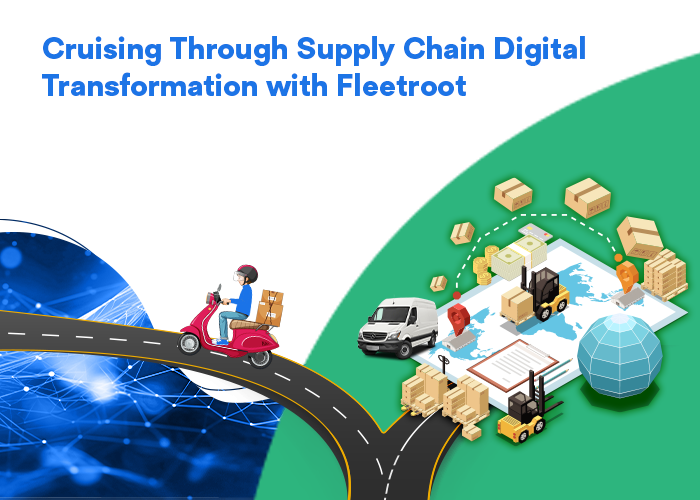In today’s business landscape, the importance of a well-optimized supply chain cannot be overstated. At Fleetroot, we embraced digital transformation to become a game-changer. The traditional approach to supply chain management is no longer sufficient to meet the demands of modern logistics. In this blog post, we will delve into the world of supply chain digital transformation, with a focus on Fleetroot’s innovative solutions and strategies.
1. The Need for Supply Chain Digital Transformation
The traditional supply chain model relied heavily on manual processes, leading to inefficiencies, delays, and higher operational costs. However, the emergence of digital technologies has paved the way for a transformative shift in how supply chains are managed. Several key factors highlight the necessity of digital transformation in supply chain management:
Customer Expectations: In the age of e-commerce and fast delivery, customers demand quick and accurate deliveries. Digitalization allows companies to meet these expectations by providing real-time visibility into the supply chain.
Data Explosion: The sheer volume of data generated in the supply chain is overwhelming. Utilizing advanced analytics and machine learning, companies can extract valuable insights from this data to enhance decision-making.
Globalization: Supply chains have become increasingly complex due to globalization. Managing a global supply chain efficiently requires digital tools that can provide end-to-end visibility and control.
2. Fleetroot’s Digital Transformation Journey
We, at Fleetroot, recognized the need to adapt and innovate in the face of changing market dynamics. Here’s how we embarked on its digital transformation journey:
Data-Driven Decision-Making: Fleetroot leveraged its vast database of fleet and logistics data to develop predictive analytics tools. These tools help businesses make informed decisions regarding route optimization, vehicle maintenance, and fuel efficiency.
IoT Integration: Internet of Things (IoT) technology is at the heart of our digital transformation. By equipping vehicles with sensors and connectivity, we enabled real-time tracking of assets and collected crucial data points for analysis.
Cloud-Based Solutions: We transitioned to cloud-based software solutions, providing scalability and accessibility. This move allowed clients to access their fleet management data from anywhere, streamlining operations and reducing IT infrastructure costs.
AI and Machine Learning: By integrating AI and machine learning algorithms into their software, we improved predictive maintenance, driver behavior analysis, and even optimized delivery routes, reducing operational costs and enhancing customer satisfaction.
3. Benefits of Fleetroot’s Digital Transformation
Our commitment to digital transformation has yielded numerous benefits for both the company and its clients:
Enhanced Efficiency: Through real-time tracking, automated reporting, and predictive analytics, our digital solutions have significantly improved operational efficiency for its clients. This translates into cost savings and quicker response times.
Cost Reduction: Predictive maintenance and route optimization have led to reduced fuel consumption and maintenance costs. Clients using our digital tools have reported substantial savings.
Improved Customer Satisfaction: Accurate tracking and estimated delivery times have enhanced customer satisfaction. Fleetroot’s digital transformation ensures that deliveries are made on time and with greater accuracy.
Data-Driven Insights: Our analytics tools provide valuable insights into fleet performance and logistics operations. This data-driven approach enables continuous improvement and strategic decision-making.
4. Challenges and Considerations
While the benefits of supply chain digital transformation are evident, companies must also navigate certain challenges:
Cybersecurity: With an increased reliance on digital tools and data, the risk of cyberattacks grows. We place a strong emphasis on cybersecurity to protect sensitive client information.
Integration Complexity: Integrating various digital solutions into an existing supply chain can be complex. Companies must carefully plan their digital transformation strategy to ensure a smooth transition.
Training and Change Management: Employees may resist change or face challenges in adapting to new technologies. Adequate training and change management are essential for a successful transformation.
Data Privacy: With the collection of vast amounts of data, companies must be mindful of data privacy regulations. We ensure that data is collected and used in compliance with relevant laws.
5. The Future of Supply Chain Digital Transformation
As technology continues to evolve, supply chain digital transformation is far from a one-time process. Companies are continuously innovating to stay ahead of the curve. Here are some trends that are shaping the future of supply chain management:
Blockchain: Blockchain technology offers transparency and security in the supply chain. It can be used to track products from their source to the end consumer, reducing fraud and ensuring product authenticity.
Automation and Robotics: Automation in warehouses and the use of robotics for tasks like order picking are becoming increasingly common. These technologies improve efficiency and reduce human error.
Predictive Analytics: Predictive analytics will become even more advanced, enabling companies to foresee issues and opportunities in the supply chain before they arise.
Sustainability: Sustainability concerns are driving companies to adopt eco-friendly practices in their supply chains. Digital tools can help track and reduce the environmental impact of logistics operations.
Conclusion
In a world where supply chain management is a critical factor in a company’s success, digital transformation is no longer a luxury but a necessity. Our journey through digital transformation serves as a testament to the profound impact these changes can have on operational efficiency, cost reduction, and customer satisfaction.
As supply chains continue to evolve, companies that embrace digitalization and innovation will position themselves as leaders in their respective industries and provide valuable insights for businesses seeking to thrive in the digital age.




